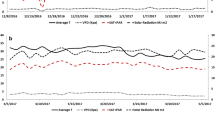Abstract
Aims
Sorghum is commonly grown under dryland conditions, where yields are limited by soil water deficits. Yield increase may be possible by selecting genotypes that express traits that are desirable for water-limited conditions. Water conservation is one possible trait for increasing yield since this trait could increase water availability during critical stages of crop development. Water conservation could be achieved by slower transpiration rate with soil drying initiated at a high fraction of transpirable soil water (FTSW) so that the use of soil water is extended over a longer period of time. This water conservation strategy may allow the crop to have water available during the critical phase of grain filling. Therefore, the objective of this study was to compare genotypes of sorghum for possible differences in the threshold for the decline in transpiration.
Methods
Sixteen sorghum genotypes were selected for this study based on differences in their sensitivity to elevated vapor pressure deficit (VPD). These genotypes were subjected to dry-down experiments in pots in a greenhouse to determine the threshold FTSW for the decrease in transpiration rate as the soil dried.
Results
Differences in the FTSW threshold for transpiration decline were observed to range among genotypes from 0.32 to 0.48. The genotypes differed between low and high FTSW thresholds in the same manner as they did for a breakpoint in the VPD or lack of breakpoint, respectively. Those genotypes with high FTSW thresholds exhibited the hypothesized desired trait. However, they did not exhibit the water conserving trait of limited transpiration rate at high VPD. On the other hand, those genotypes with a low FTSW threshold were those selected for limited transpiration rate at high VPD. These genotypes also differed based on their transpiration rate under well-watered conditions with the genotypes with a low FTSW threshold exhibiting a low transpiration rate.
Conclusions
These results demonstrated that among the sorghum genotypes there are several alternative traits for enhancing soil water conservation for growth under dry land conditions.



Similar content being viewed by others
References
Devi MJ, Sinclair TR, Vadez V, Krishnamurthy L (2009) Peanut genotypic variation in transpiration efficiency and decreased transpiration during progressive soil drying. Field Crops Res 114:280–285
Devi MJ, Sinclair TR, Vadez V (2010) Genotypic variation in peanut for transpiration resonse to vapor pressure deficit. Crop Sci 50:191–196
Gholipoor M, Prasad PVV, Mutava RN, Sinclair TR (2010) Genetic variability of transpiration response to vapor pressure deficit among sorghum genotypes. Field Crops Res 119:85–90
Gholipoor M, Sinclair TR, Raza MAS, Messina CD (2012) Maize hybrid variabilitiy for transpiration decrease with progressive soil drying. J. Agron. Crop Sci. (In Review)
Hufstetler EV, Boerma HR, Carter TE Jr, Earl HJ (2007) Genotypic variation for three physiological traits affecting drought tolerance in soybean. Crop Sci 47:25–35
Kholova J, Hash CT, Kakkera A, Kocova M, Vadez V (2010) Constitutive water-conserving mechanisms are correlated with the terminal drought tolerance of pearl millet [Pennisetum glaucum (L.) R. Br.]. J Exp Bot 61:369–377
Ray JD, Sinclair TR (1997) Stomatal closure of maize hybrids in response to drying soil. Crop Sci 37:803–807
Ray JD, Sinclair TR (1998) The effect of pot size on growth and transpiration of maize and soybean during water deficit stress. J Exp Bot 49:1381–1386
Ritchie JT (1973) Influence of soil water status and meteorological conditions on evaporation from a corn canopy. Agon J 65:893–897
Sadras VO, Milroy SP (1996) Soil–water thresholds for the responses of leaf expansion and gas exchange. A review. Field Crops Res 47:253–266
SAS Institute (2003) SAS users guide. Version 9.1. SAS Institute, Cary
Sinclair TR, Ludlow MM (1986) Influence of soil water supply on the plant water balance of four tropical grain legumes. Aust J Plant Physiol 13:329–341
Sinclair TR, Zwieniecki MA, Holbrook MN (2008) Low leaf hydraulic conductance associated with drought tolerance in soybean. Physiol Plant 132:446–451
Acknowledgments
The authors gratefully acknowledge the financial support of the Kansas Grain Sorghum Commission. Contribution no. 12-068-J from Kansas Agricultural Experiment Station.
Author information
Authors and Affiliations
Corresponding author
Additional information
Responsible Editor: Rafael S. Oliveira.
Rights and permissions
About this article
Cite this article
Gholipoor, M., Sinclair, T.R. & Prasad, P.V.V. Genotypic variation within sorghum for transpiration response to drying soil. Plant Soil 357, 35–40 (2012). https://doi.org/10.1007/s11104-012-1140-8
Received:
Accepted:
Published:
Issue Date:
DOI: https://doi.org/10.1007/s11104-012-1140-8




